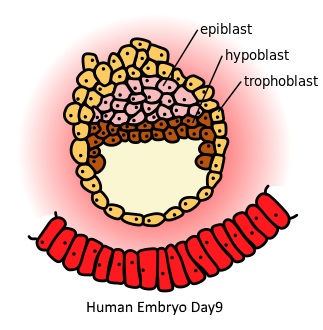
The hypoblast (inner germ layer of gastrula) forms the
A. Ectoderm
B. Mesoderm
C. Endoderm
D. None of the above.
Answer
585.3k+ views
Hint: The endoderm is a prominent germ layer which is formed during the period of animal embryogenesis. It is essentially derived from the hypoblast.
Complete answer: The hypoblast is an important transient structure which greatly contributes to the development of the extraembryonic mesoderm along with the yolk sac and plays a crucial role in signaling to establish the characteristic axial patterning in the embryo itself.
The inner cell mass (ICM) segregates into a bilaminar embryonic disc (i.e. bilaminar blastoderm) which again consists of two epithelial layers, each having a distinct lineage: the external epiblast (it is present dorsally) and the internal hypoblast (it is present ventrally). During the period of gastrulation, the process in which the three germ layers (ectoderm, mesoderm, and the endoderm) of the trilaminar embryonic disc are formed, cells from the epiblast migrate, through the primitive streak, into the inside part of the embryo, in a process which is better known as ingression.

Additional information: Ingression is the process which involves cellular epithelial-to-mesenchymal transition (EMT).
The initial wave of these migrating cells streams through the primitive streak, thus displacing the hypoblast cells to become the definitive endoderm, which eventually produces the future gut derivatives and gut linings.
So, the correct answer is C. Endoderm.
Note: The hypoblast is located beneath the epiblast and is made up of small cuboidal cells. The cells of the hypoblast ultimately form the endoderm, which in turn gives rise to the development and formation of the respiratory and digestive tracts.
Complete answer: The hypoblast is an important transient structure which greatly contributes to the development of the extraembryonic mesoderm along with the yolk sac and plays a crucial role in signaling to establish the characteristic axial patterning in the embryo itself.
The inner cell mass (ICM) segregates into a bilaminar embryonic disc (i.e. bilaminar blastoderm) which again consists of two epithelial layers, each having a distinct lineage: the external epiblast (it is present dorsally) and the internal hypoblast (it is present ventrally). During the period of gastrulation, the process in which the three germ layers (ectoderm, mesoderm, and the endoderm) of the trilaminar embryonic disc are formed, cells from the epiblast migrate, through the primitive streak, into the inside part of the embryo, in a process which is better known as ingression.

Additional information: Ingression is the process which involves cellular epithelial-to-mesenchymal transition (EMT).
The initial wave of these migrating cells streams through the primitive streak, thus displacing the hypoblast cells to become the definitive endoderm, which eventually produces the future gut derivatives and gut linings.
So, the correct answer is C. Endoderm.
Note: The hypoblast is located beneath the epiblast and is made up of small cuboidal cells. The cells of the hypoblast ultimately form the endoderm, which in turn gives rise to the development and formation of the respiratory and digestive tracts.
Recently Updated Pages
The number of solutions in x in 02pi for which sqrt class 12 maths CBSE

Write any two methods of preparation of phenol Give class 12 chemistry CBSE

Differentiate between action potential and resting class 12 biology CBSE

Two plane mirrors arranged at right angles to each class 12 physics CBSE

Which of the following molecules is are chiral A I class 12 chemistry CBSE

Name different types of neurons and give one function class 12 biology CBSE

Trending doubts
Which are the Top 10 Largest Countries of the World?

What are the major means of transport Explain each class 12 social science CBSE

Draw a labelled sketch of the human eye class 12 physics CBSE

Differentiate between insitu conservation and exsitu class 12 biology CBSE

State the principle of an ac generator and explain class 12 physics CBSE

Differentiate between homogeneous and heterogeneous class 12 chemistry CBSE




